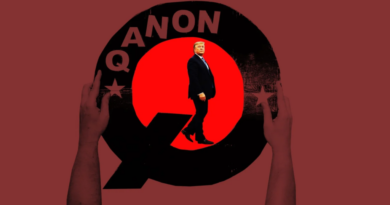‘Gotham’: Did the creators of QAnon draw from the cult-hit show?
Wherever it’s portrayed, the Batman mythos is a dark and amazing place where mysteries and sinister plots abound. The cult favorite TV show Gotham, which ran on Fox for 100 episodes, is no exception. In our current zeitgeist, many would have you believe that similar conspiracies are rife in real life, too.
Gotham lasted five seasons, from 2014 to 2019. The episodes we’ll be looking at in this series of articles span from the first all the way through to season 4, episode 6, which aired on October 26, 2017, two days before the far-right political conspiracy theory that would become QAnon first appeared on imageboard website 4Chan.
What do these two things have to do with each other? Watching Gotham for the first time recently, I started to notice ideas popular with QAnon followers portrayed in the show. And they began popping up more and more as the series went on, right up to the point when QAnon “went public.”
Before beginning, I want to state very clearly that coincidences do exist. It might not be that the men who posed as Q, most likely Paul Furber and later Ron Watkins, got their inspiration from Gotham. But it’s important to note these similarities, as understanding how close a fictional TV show is to a conspiracy theory that touts itself as “true” could offer insight for those enmeshed in QAnon and other baseless conspiracy theories.
Further, even if the purveyors of Q really did get inspiration from Gotham, that doesn’t mean Gotham itself caused QAnon. The elements that inspired QAnon are far older than the TV show, and they’re woven into the show because they are such long-standing myths. Furber and Watkins, if they were in fact fans of Gotham, may have just stolen these elements for their own LARP.
So, that said, let’s go down this rabbit hole, and as Q would say, “enjoy the show.”
Within the first few episodes of Gotham, we’re already knee-deep in what would become QAnon tropes, including a child-trafficking ring perpetrated by a pharmaceutical company named Quillan, with a giant neon green “Q” sign. There’s also an episode that involves mind control through hypnosis and a Manchurian Candidate being activated for duty. QAnon likes to tell the world that MKUltra was a success (it was not), and that it’s still active today. Here a man has been hypnotized to believe he’s the reincarnation of a dead serial killer who preyed on the children of Gotham’s richest families — or, the “elites.”
Despite Gotham showing its “pilled” nature at the very beginning, the QAnon similarities fade until season 1, episode 14, which first aired on February 2, 2015. It’s then we’re introduced to a simultaneous plot involving a murderer who steals adrenal glands from people who suffer from intense phobias, and an illegal kidnapping and organ-harvesting ring.
Adrenochrome — a chemical produced by the oxidation of adrenaline — is a popular part of the QAnon myth. In the Quniverse, children are kidnapped and tortured in order to heighten their fear, which produces adrenochrome. A terrible cabal of elites then harvests this to prolong their lives and look younger. (Why they’d need to do this when the chemical can be purchased from drug manufacturers, without a prescription, is anyone’s guess.)
Adrenochrome isn’t unique to QAnon or Gotham (and is in fact never mentioned by name in Gotham). Aldous Huxley and Timothy Leary were looking into the use of adrenochrome to cure schizophrenia during their experiments at Harvard (the “lighter” side of MK-Ultra; all volunteers were dosed with LSD or other hallucinogens with prior, informed consent). In pop culture, the English rock band The Sisters of Mercy wrote a performed a song called “Adrenochrome” in the 1980s.
In Gotham, we learn that a Dr. Crane is behind these adrenochrome killings. Crane’s wife had died in a house fire while Crane, so consumed by his own fear, failed to save her. Only he and his son, Jonathan, survived.
Crane has been researching a way to cure fear. He attends meetings for phobics to learn their greatest fear, then murders them by manner of this fear, extracts their adrenal glands post-mortem, and harvests the adrenochrome (again, never mentioned by name.) Crane intends to inject himself and his son with this substance, which causes mind-breaking hallucinations in which they are forced to deal with their fears. Crane manages to cure himself, but injects too much into his son, who later becomes the Scarecrow.
Dr. Crane is shot and killed by Jim Gordon and Harvey Bullock of the GCPD, and during their investigation, they discuss the autopsy results of the latest victim with the medical examiner. When speaking of the missing adrenal gland, the M.E. says, “It produces cortisol, the hormone that gives us that adrenalized fight-or-flight reaction .. .All I can think of is at the moment of death the victim’s adrenals would produce a massive, highly elevated form of cortisol.”
The mention of cortisol is somewhat unique, yet on April 9, 2021, Ron Watkins, the man most likely behind Q’s second incarnation, hyped the cortisol connection on the conspiracy theorist-favored messaging app, Telegram:
And that’s just the beginning. Long before the first season of Gotham is over we’re witness to tons more Qanon tropes — three years before the conspiracy theory even came along.
In other episodes, Bullock and Gordon investigate a murder at a traveling carnival, which was perpetrated by a Joker-analogous character named Jerome Valeska, who was introduced as part of a “false flag” operation. Valeska was hired to stage an assassination attempt on a mayoral candidate so the candidate could look like a hero, and thus secure more votes. Velska actually died as part of the attack, but it’s later revealed that his body was cryogenically frozen.
In the Quniverse everything is a “false flag.” Shortly after George Floyd’s death in 2020, QAnon began circulating rumors it was a hoax, and that a crisis actor was paid to play the role of Floyd, just like the crisis actors who played bereaved parents of children who supposedly never existed, in the wake of the Sandy Hook Elementary School shootings.
Toward the end of season one, we begin to learn of the nefarious goings-on at a place called Indian Hill, located near Arkham Asylum. Indian Hill is supposed to be a waste disposal site, but it’s actually the scene of illegal human experimentation to create what the Nazis would refer to as Ubermensch – human monsters with superhuman abilities. It’s revealed that Valeska is part of these experiments, and his frozen body is later revived. By that time, a cult has sprung up around his memory (more on that later).
AIPT Science is co-presented by AIPT and the New York City Skeptics.
Like what we do here at AIPT? Consider supporting us and independent comics journalism by becoming a patron today! In addition to our sincere thanks, you can browse AIPT ad-free, gain access to our vibrant Discord community of patrons and staff members, get trade paperbacks sent to your house every month, and a lot more. Click the button below to get started!







